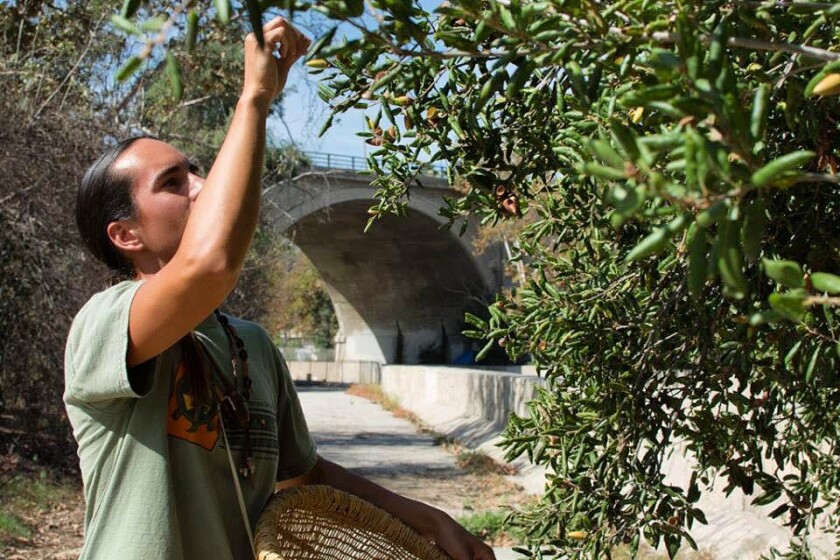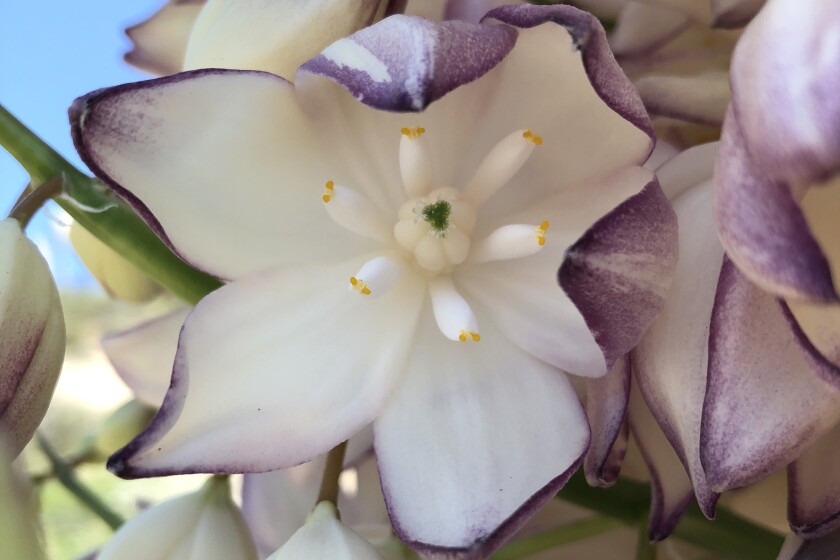
What are the 7 most important native plants in L.A.? We asked an expert
California has more types of native plants than any other state in the U.S., a third of which are found nowhere else on Earth. Why should we care about native plants? They are the foundation of our ecosystem, they support our native animal species like the monarch butterfly, and they are part of California’s rich Indigenous peoples history.
Indigenous cultural and plant educator Nicholas Hummingbird is on a mission to spread his knowledge of native plants through the traditional and ongoing knowledge of Indigenous peoples. Hummingbird descends from Cahuilla and Apache nations and was the founder and previous manager of Hahamongna Nursery, a native plant nursery in Pasadena. He has worked on the Channel Islands doing large-scale habitat restoration with the National Park Service. Hummingbird shares his knowledge of native plants through speaking engagements with high schools, universities and Zoom webinars that he announces through his Instagram.
Here, Hummingbird shares what he believes to be the seven most important native plants. Learn more about California native plants through our @latimesplants Instagram Live session with Hummingbird.

Nicholas Hummingbird, Indigenous cultural and plant educator.
(Nicholas Hummingbird)
Let me share with you just one part of an ongoing story, a story that is thousands of years old, and it centers around what is the human translation of our natural environment here in Southern California. This place has recently become home for millions of people from around the world and a focal point of environmental loss and devastation; tied to that very plight is the story of indigenous peoples. I cannot separate the plight of our ecosystems full of life given by plants, stewarded by animals and contextualized by indigenous peoples out of the scope of where we find ourselves today.
See the images of the beauty that we still have here in Southern California, the languages that speak to them and a people who continue to be the caretakers, activists and stewards of them. Acknowledging native plant presence hasn’t always been on most gardeners’ minds or a part of their awareness. Hopefully that can change. It’s also how I can relate as a native person, that I feel that there is little acknowledgment when it comes to the natural environment including native plants, native animals and native peoples.

Coast live oak.
(Nicholas Hummingbird)
1. Coast live oak (Quercus agrifolia)
If there was a specific native plant I was to begin with, it would be with our native oak trees. Once abundant and plentiful all over California, too few remain of these long-lived and giving ancestors. To consider a plant medicinal, most people think of pain or comfort management, but that’s too simple; medicine is a healthy land, healthy water and healthy air, all of which the oak trees constantly give us. As a keystone species, their existence provides habitat for thousands of beings while sequestering large amounts of carbon at net zero supplemental water. The same cannot be said for every non-native tree in our landscapes today. Oak trees have incredible power. The acorns they produce nourish all beings, from birds to deer and even bears, but most important, Indigenous peoples. I pray we can allow oak trees to flourish once more in our urban space as they have for thousands of years. That’s the first step in helping to heal this place and create an equitable environment for the future as it has always been in the past.

Lemonade berry.
(Nicholas Hummingbird )
2. Lemonade berry (Rhus integrifolia)
This plant is fire-resistant and iconic of the rarest ecosystems we have left, the coastal sage scrub plant community. Lemonade berries curb erosion and adapt to a variety of soil types; they are an effective fire barrier and great for pruning into hedges. The lemonade berry is a direct replacement for most non-native shrubs in our urban landscapes. Their berries, once boiled and steeped for a couple of days, will make a drink that tastes just like lemonade and is full of antioxidants and antivirals.

Chaparral yucca.
(Nicholas Hummingbird)
3. Chaparral yucca (Hesperoyucca whipplei)
The chaparral yucca is a plant someone can easily ignore and overlook but it’s truly undeniable when it flowers. Unfortunately, this is the last stage of the yucca’s life cycle when it blooms after an average 10-year period. But the plant’s afterlife is just as crucial in providing millions of seeds that nourish dozens of species and, one day, sprout new plants. One important indicator of yucca going to flower is an environmental sign that much of our major rainstorms are behind us as we head into summer. Chaparral yucca are crucial in that they provide so much culture to Indigenous peoples, but one culture cannot be ignored and that is the symbiotic relationship with the yucca moth, the only pollinator that can give this plant its afterlife of seed and continuance.

Toyon produces clusters of small red berries.
(Nicholas Hummingbird)
4. Toyon (Heteromeles arbutifolia)
It can be hard to believe of the 6,000-plus native plants in California, very few still are referred to by their indigenous names. Toyon comes from the Ohlone language and is just one of many names Indigenous peoples have for this plant. In fact, hundreds of names exist for toyon and most California native plants in general. The toyon once abundant in many spaces can be once again; it is a true lifeline for local and migratory species of birds, insects, mammals and humans. The plant is related to something most of us consume today: apples. These berries need processing to be edible but it is another plant that has incredible benefits to our urban and natural areas. Consider planting a toyon or replacing a non-native shrub with one. It’s an evergreen that flowers in the summer and gives berries throughout the fall and winter.
5. Common buckwheat (Eriogonum fasciculatum)
Adjacent to many spaces like freeways and developments is the unappreciated cornerstone of life in Southern California, the common buckwheat. Flowering throughout the summer months, this plant is a lifeline for pollinators like butterflies. In fact, some of the rarest butterfly species are found in SoCal and many need particular buckwheat plants in order to survive. The common buckwheat turns a beautiful rust red color toward the end of summer and into fall, signaling the seasonal change. The plentiful seeds can sustain local and migratory bird species and hopefully result in many more plants in spaces that continue to be disturbed or altered, as buckwheat is able to adapt to a changing environment. Like all native plants, common buckwheat show and teaches us resilience.

Elderberry produces clusters of dark berries.
(Nicholas Hummingbird)
6. Elderberry (Sambucus cerulea)
With elderberry gaining attention and popularity, it’s important to point out most elderberry products in stores today come from a species of elderberry that originated a world away, in Europe. Much the same variety or close to it grows locally in California. The California blue elderberry is a tree of life and possibility, flowering and providing fruit. By far one of the easiest native plants to grow, it thrives if just given the opportunity to do so. Sustainability is having a plant that benefits the environment as a whole, and that’s exactly what the California blue elderberry does.

Purple needle grass
(Nicholas Hummingbird)
7. Purple needle grass (Stipa pulchra)
In the world of plants everyone appreciates flowers, trees, fruits and vegetables. Not many will say grasses, let alone our native bunchgrass species. They are so valuable and crucial to our future. They live to be hundreds of years old, sequester huge amounts of carbon and have transitioned to be more effective than many trees in our landscape as they are less impacted by drought and wildfire. In fact, they thrive with both, because their massive root systems hold together earth, restore water and sequester huge amounts of carbon underground. Under the conditions that most trees release carbon, they keep it stored. They are a true foundation for our ecosystem and are a quick way to restore California’s environmental integrity.
Stay connected with us on social media platform for instant update click here to join our Twitter, & Facebook
We are now on Telegram. Click here to join our channel (@TechiUpdate) and stay updated with the latest Technology headlines.
For all the latest LifeStyle News Click Here
For the latest news and updates, follow us on Google News.

